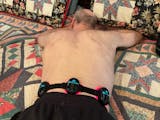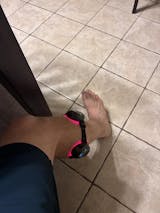Rotator cuff pain at night is a common issue for many individuals. It can interrupt sleep, making it difficult to rest and recover. The rotator cuff, which consists of muscles and tendons that stabilize the shoulder, can become strained or injured through repetitive movements or trauma. Thankfully, there are various methods to relieve this discomfort, with one of the most effective being
medical-grade red light therapy devices. In this article, we'll explore simple, actionable steps to help you alleviate rotator cuff pain and enjoy better sleep.
Why Does Rotator Cuff Pain Intensify at Night?
Understanding Rotator Cuff Injuries
Rotator cuff injuries can range from mild inflammation to severe tears. At night, these injuries may feel more intense because there’s less movement, which can cause the muscles to stiffen and inflame. The lack of motion can worsen pain, making it harder to sleep through the night.
The Role of Inflammation at Night
At night, your body’s natural healing process focuses on repairing tissue damage. However, during this time, inflammation can increase due to less blood circulation while lying still. This heightened inflammation can amplify the pain in the affected shoulder, making it more noticeable when you're trying to sleep.
How Sleeping Positions Affect Your Shoulder
The way you sleep can directly affect your rotator cuff pain. Sleeping on the injured shoulder can compress the tissues and irritate the pain. On the other hand, poor alignment while sleeping—such as a head position that isn’t well-supported—can worsen your discomfort by causing additional strain on the shoulder area.
Best Sleeping Positions for Rotator Cuff Pain Relief
Sleeping on Your Back with Proper Pillow Support
One of the best ways to minimize shoulder pain at night is to sleep on your back. This position allows the shoulder to rest without pressure. To improve comfort, make sure to use a pillow that supports the neck and aligns the head with the spine, reducing strain on the shoulder muscles.
Side Sleeping with a Pillow Between Your Arms
If you prefer sleeping on your side, try placing a pillow between your arms. This creates space between your upper and lower arms, which can prevent compression on the shoulder. It also helps keep your shoulder in a neutral position, which reduces stress and pain while you sleep.
Avoiding Sleeping on the Affected Shoulder
When dealing with rotator cuff pain, it’s crucial to avoid sleeping on the affected side. Sleeping on your bad shoulder can increase inflammation and pain, making it harder to heal. If you have difficulty maintaining this position, consider using a pillow to prop yourself up and prevent rolling onto the injured side.
How Red Light Therapy Helps with Rotator Cuff Pain
The Science Behind Red Light Therapy
FDA approved red light therapy works by penetrating the skin and stimulating cells to enhance blood circulation. This process helps reduce inflammation and speeds up tissue repair, which can be especially beneficial for rotator cuff injuries. When applied to the affected area, it promotes healing by encouraging the production of collagen and other healing compounds.
Benefits of Red Light Therapy for Chronic Pain
For chronic rotator cuff pain, using
red light therapy devices - PRUNGO FluxGo can significantly reduce both inflammation and pain. Regular sessions with these devices can improve the mobility of the shoulder joint and help manage pain without the need for invasive treatments or medications.
How to Use Medical-Grade Red Light Therapy Devices
Using a red light therapy machine is simple. Place the device near the affected area, ensuring the light directly targets the shoulder. Depending on the device, you may need to use it for 10-20 minutes a session, multiple times a week. The consistent application will yield the best results for pain relief and recovery.
Non-Surgical Treatments for Rotator Cuff Pain
Physical Therapy and Stretching Exercises
Physical therapy is a great way to relieve shoulder pain. Gentle stretches can help loosen tight muscles and increase blood flow to the rotator cuff. Therapy exercises like pendulum swings or wall push-ups can strengthen the shoulder muscles, preventing further injury and providing relief from pain over time.
Using Ice and Heat for Pain Relief
Applying ice to the shoulder for 15-20 minutes can help reduce inflammation and numb the pain. After the initial inflammation has subsided, switching to heat therapy can help relax the muscles and improve blood circulation, which can further alleviate discomfort and promote healing.
Anti-inflammatory Medications
Non-steroidal anti-inflammatory drugs (NSAIDs), like ibuprofen, can provide quick relief from pain and swelling. These medications can be taken before bed to help manage pain, making it easier to fall asleep. However, they should be used sparingly and under the guidance of a healthcare professional.
The Role of Sleep Hygiene in Managing Rotator Cuff Pain
Creating a Comfortable Sleep Environment
Your sleep environment plays a big role in how well you rest. Ensure that your mattress and pillows support proper spinal alignment. A comfortable, firm mattress can prevent pressure on the shoulder and help you sleep better, ultimately aiding in the recovery of your rotator cuff injury.
Developing a Consistent Sleep Routine
Going to bed and waking up at the same time each day helps regulate your body’s internal clock. Consistent sleep patterns allow for better tissue recovery and can improve the overall quality of your sleep, reducing the likelihood of waking up with more pain from your rotator cuff injury.
Avoiding Stimulants Before Bedtime
Caffeine, nicotine, and heavy meals close to bedtime can interfere with sleep quality. Avoiding these can help you achieve deeper, more restorative sleep, allowing your body to heal faster and reduce discomfort related to rotator cuff pain.
When to Seek Professional Help for Rotator Cuff Pain
When Pain Becomes Chronic or Severe
If your rotator cuff pain persists for weeks or becomes unbearable, it’s important to consult with a healthcare professional. Ignoring persistent pain can lead to further injury and limit your mobility.
Diagnostic Imaging for Rotator Cuff Injuries
To determine the severity of the injury, your doctor may recommend imaging tests, such as an MRI or ultrasound. These tests provide a clear picture of the damage and help guide treatment options, whether it’s physical therapy or surgical intervention.
Surgical Options for Severe Injuries
In cases of severe rotator cuff tears, surgery might be necessary. This can involve repairing the torn tendons and reattaching them to the bone. Surgery is typically reserved for cases where non-surgical treatments have not been effective.
Tips for Managing Rotator Cuff Pain During the Day
Modifying Daily Activities to Avoid Strain
Avoid activities that involve overhead motions or lifting heavy objects, as these can put extra strain on the rotator cuff. Try using ergonomic tools and adjusting your workspace to avoid further injury.
Using Supportive Braces or Slings
Wearing a supportive brace or sling during the day can help stabilize the shoulder and prevent movements that could worsen the pain. This provides extra protection while your shoulder heals.
Staying Active with Gentle Exercises
Low-impact exercises, like walking or swimming, can keep the rest of your body active without straining the shoulder. Focus on movements that don’t exacerbate the pain but help maintain overall strength and flexibility.
Conclusion
Relieving rotator cuff pain is crucial for getting the rest your body needs to promote recovery. From proper sleeping posture to non-surgical treatments such as
red light therapy devices, there are many ways to alleviate discomfort. Combining physical therapy, managing inflammation, and adjusting sleep habits can all help achieve more restful sleep. If the pain persists or worsens, seeking professional help is essential. For long-term relief, you can consider advanced therapies such as
red light therapy panel. If you are looking for a solution specifically for facial treatment, a
red light therapy mask may be a good option.





















Share:
How to Strengthen Lower Back
How to Cure Neck Pain Fast: A Complete Guide to Relief